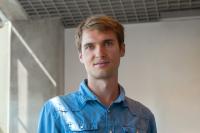Marie Skłodowska-Curie Individual Fellowship grant at the WUT Faculty of Physics

Marcin Patecki, Ph.D., Eng., from the WUT Faculty of Physics, photo: Dmitry Nadtocheev
The prestigious grant was awarded to Marcin Patecki, Ph.D., Eng., who will implement the project The ALICE fixed-target programme layout using bent crystals at the CERN Large Hadron Collider. Its goal is to expand the research potential of the ALICE experiment at the Large Hadron Collider.
The European Organization for Nuclear Research (CERN) studies the smallest components of matter using accelerators, including the Large Hadron Collider (LHC). At the LHC, beams of protons or lead nuclei are accelerated to huge energies and collided head-on inside detectors (including ALICE) to observe new particles produced in this way and interactions between them. Colliding such small objects requires a very precise process of accelerating and controlling the beams. This can be compared to a situation where we want to shoot down a bundle of arrows fired by a group of archers using a similar bundle of arrows fired in the opposite direction by a similar group of archers, only that the “arrows” are much smaller and their velocities are close to the speed of light.
The task is, therefore, very difficult and in practice it can be achieved only for a few types of atomic nuclei (including protons). In the standard process of preparing a beam for a collision, some beams that clearly deviate from others are absorbed in special barriers (collimators). The project is aimed at researching the possibility of using bent silicon crystals to intercept such particles and direct them to a special fixed target placed inside the ALICE detector. This will make it possible to conduct additional experiments in particle physics and study processes that are unavailable in head-on collisions at the LHC, especially as the target may be built using virtually any kind of material.
The possibility of using crystals to control the path of particles results from the principles of quantum mechanics, but is actually very easy to illustrate. A crystal has an ordered internal structure, in particular it may have a layered structure, where crystal planes are separated from each other with empty space, creating a sort of a railway track. Particles that strike at the crystal follow along the track so that they leave the crystal without any significant disruption. In addition, the crystal may be bent in the production process, which means that the tracks inside the crystal are bent as well, making it possible to change the trajectory of the particle. The process is very efficient: a crystal a few millimeters long may cause deflections equivalent to the strongest available magnets with the length of several meters, operating without any power source.
Using crystals to control the trajectory of particles is a completely new technology and it is not commonly used in accelerators yet. The project would be the first case of using crystals to collide particles with a fixed target inside a detector, which opens up completely new research opportunities.
The research will last two years and will be conducted under the supervision of Daniel Kikoła, Ph.D., D.Sc, Eng. at the Nuclear Physics Division at the WUT Faculty of Physics.
The ALICE fixed-target programme layout using bent crystals at the CERN Large Hadron Collider research project is financed from the European Marie Skłodowska-Curie Individual Fellowship grant under the Horizon 2020 program.
The MSCA Individual Fellowship grant has been awarded at WUT for the first time.







